Abstract
This paper details a method, which has been called FRIDA, applied by the authors within this study based on the collaborative and interdisciplinary development of accessible software that is usable by people with autism spectrum disorder (ASD). To this end, the context of this study is based on the adaptation of the Design Thinking model as a strategy for interdisciplinary collaborative work between clinical therapists and software developers. This is complemented by a human-centered design (DCH) approach to obtain accessible software aimed at people with ASD level 1. Each of the stages of Design Thinking is detailed in order to obtain the personalized design of accessible software, as well as the activities carried out in case studies in Colombia, Spain, and Portugal with eight children diagnosed with ASD. As a result, we present the design of FRIDA’s components for interdisciplinary collaborative work and the design of personalized software that was developed for some children with ASD who participated in this study. For these children, it is demonstrated that the use of personalized and collaboratively designed software facilitates the development of specific social skills more quickly than with conventional clinical therapies.
1. Introduction
1.1. Background
As antecedent experience to this document, it is necessary to cite the authors Constaín M. et al. [1], who start from a diagnosis of the scarcity of accessible software, with the possibility of customizing the elements and activities of its interface, which facilitates its linkage to therapies based on the management of behavior and communication of children with autism spectrum disorder (ASD). This study is based on the use of software focused on strengthening social and emotional skills, as well as on the characteristics of the treatment processes for children with ASD. The procedure is validated using qualitative and quantitative metrics and analyses with evaluation indicators on the appropriation or strengthening of emotional skills in children with ASD and the definition of the characteristics of the software developed with co-design techniques that involve the children themselves. This document, therefore, presents the progress that was made at the time on the design of an interdisciplinary intervention strategy to achieve the development of personalized software, according to the intellectual conditions and needs of therapeutic work that are required by each particular person.
This study aimed to test the effectiveness of the use of software in the treatment processes for ASD, especially in the development of social and emotional skills that favor their connection with social environments. It was based on an exercise that explored the context of using technology in the therapeutic processes for people with ASD [2]. Three diagnostic activities were carried out in clinics that work on autism treatment processes. Surveys were applied to therapists and family members of children with autism in order to identify the levels of using technological tools in these treatments, coinciding with what was presented by Benton and Johnson in [3] regarding the lack of personalized use of software.
The diagnosis carried out with these entities allowed us to identify their interest in the use of accessible software focused directly on users with ASD. It also identified the need to customize this software according to the individual treatment requirements of each person with ASD. This study found that more than 95% of therapists believe that the existence of software that supports the treatment of people with ASD is necessary to improve the quality of life of these children. In addition, there is a need for a greater number of software applications aimed at this type of user [4].
At this stage, information was collected from therapists and parents of children with ASD from four Spanish-speaking countries: Colombia, Mexico, Argentina, and Spain, as well as the United States and Germany. The information collected allowed us to broaden the level of understanding of ASD and the implications it has for the family environment of those who suffer from it. This exercise of collecting information from family members also made it possible to identify that they consider it necessary to have a greater number of computer applications focused directly on the management of ASD that can be easily accessed, and which, in addition, complement therapeutic activities inside or outside care institutions.
Similarly, a review of Google and Apple application databases was carried out to identify software that is aimed at users with ASD and thus identify the design characteristics with which they were created and evaluate their usability for people with ASD. This same activity included the inquiry carried out to software development companies about the existence of a production line of accessible software for people with ASD, as well as their perception of this type of application.
It was shown that the use of these tools in therapeutic contexts allows a generalization of behavior to a more natural context for a child with autism [2]. Therefore, the aim of this diagnostic activity was to verify whether the use of specialized software and mobile devices allowed these children to advance in their treatment, outside the clinical setting, being able to use the app at home to communicate with their close social ties.
This stage included a systematic review of the literature where emotional intelligence skills are deepened, especially self-knowledge and social skills; the most relevant characteristics of autism spectrum disorder; what treatment and education programs exist and how effective they are; notions of user-centered design (UCD) and accessibility; the typology of existing mobile applications for the treatment of autism; and finally, the metrics and heuristics that may exist to evaluate the usability of accessible applications [1].
At the end of this activity, according to the criteria defined for this study, the tools that presented the best usability results for people with ASD were selected. This software underwent a heuristic evaluation by experts before being linked to the formal treatment of children with ASD. This activity identified four mobile applications with the best result from the heuristic evaluation carried out by an expert in user-centered design, a software developer, and a graphic designer.
The use of this software in the treatment of ASD was validated using a case study with two girls with ASD aged between 7 and 10 years. The purpose of the case study was to verify whether the use of specialized software and mobile devices allows for advancing the results of the treatment of children with ASD with the development of some emotional and social skills such as self-recognition and social functioning.
The evaluation of the emotional effect on the children when using the selected software was carried out using the facial recognition technique [5]. For this purpose, E-motion software (version 2.0; developed at the University of North Carolina, USA) was used, which makes it possible to identify the emotions expressed by a person’s face with facial recognition technology. The algorithm contained in E-motion makes it possible to recognize the type of emotion expressed by validating the movements in the muscles of the face.
The results of the monitoring of emotional changes using the facial recognition technique showed that working with pictograms and developing activities analogous to the daily life of an autistic child increases the level of security, and this is expressed in their facial expressions.
After carrying out several experimentation sessions with girls with ASD, where the selected software was used in the context of treatment based on the management of pictograms, a relationship was obtained between the activity carried out and the predominant emotion that originated it. Based on all the above elements, some recommendations that may serve as support for the treatment of autism are proposed:
- The use of pictograms in apps for mobile devices facilitates the permanence of the user with ASD in therapeutic activities due to their already proven familiarity with traditional therapies.
- The use of gamification techniques for the development of activities within the app generated for users with ASD motivates the participation of children in the planned tasks.
- The use of technological devices, such as smartphones or digital tablets, provides new tools to therapists that had previously been little explored.
- Existing software that is geared toward users with ASD is viable to link to autism treatment processes, but it will not always be completely useful because the features, motivations, and design differ from the requirements of different users. In accordance with the above, the design of these apps must be customizable according to the requirements of different users and in short periods of time to facilitate their use in larger groups.
- The software architecture used for the design of accessible apps does not differ from conventional software; however, it is necessary to customize the functional requirements for each user based on collaborative creation methods.
After some additional stages in the aforementioned study, it was necessary to make known another part of its development that focuses on the collaborative work between professionals from different disciplines, especially therapists who care for people with ASD and software developers. This forms part of the results presented in this document.
1.2. Theoretical Context
As a theoretical context of the topic on which this document is focused, it is important to remember that the neurological development of the human brain occurs during the first years of life, a period during which our nervous system is strengthened and the adaptation to the environment that surrounds us occurs. Typically, within the first five years, motor, sensory, cognitive, and emotional functions that are crucial to individuals’ physical, intellectual, and social development are established [2,3]. When the maturity of these neurological brain functions falls below normal parameters, neurodevelopmental disorders occur that manifest themselves from the first months or years and last a lifetime. These disorders progressively affect intellectual and motor functions over time, ultimately affecting the emotional and social skills of those affected [4,5].
One of the most prevalent intellectual and neurocognitive developmental disabilities in this category is autism spectrum disorder (ASD). According to the World Health Organization (WHO), ASD affects 1 in every 100 people worldwide [6].
Autism is considered one of the permanent neurodevelopmental disorders, where cognitive functions related to social interaction, communication, behavior, and interests, among others, are affected. According to [7], in various social and educational contexts, significant emphasis is placed on the emotional aspect of communication and learning processes. However, addressing the emotional aspect remains a complex challenge today.
As a result, in recent decades, there has been a wide range of hypotheses about autistic disorder, focusing more on its causes than on understanding the underlying mental processes. Consequently, the efficacy of various treatments for the “rehabilitation” of individuals with autism has been limited [8].
Recent research presented in [3,4,5] identified the classification of ASD intervention and treatment programs into four distinct categories:
1. Behavioral programs;
2. Medications supplied;
3. Education and learning programs;
4. Other treatments and alternative therapies.
As for the most common treatments for ASD, researchers have struggled to determine which ones are most effective for specific cases [9]. For example, a study by Afif et al. [6] demonstrated the benefits of emotional regulation for people with ASD using a cuddle machine, providing deep pressure to induce a calming effect before other interventions. Similarly, in several studies, it was unclear whether a particular program was generally more effective for older or younger children or those with severe or mild ASD. This underscores that what works for one child with ASD may not produce the same results for another, even if they share similar characteristics related to the disorder [7].
However, recent research generally agrees that interventions based on behavioral and communication approaches are among the most promising options, especially during the first few years after an ASD diagnosis [4]. This is valid as long as the therapeutic methods are tailored to the unique characteristics of each individual.
Given the challenges mentioned above, it is imperative to develop intervention strategies that promote communication and the collaborative creation of customized tools. These strategies should facilitate the alignment of ASD treatments with the specific attributes of each individual’s condition, ensuring a more effective and personalized therapeutic approach.
In this context, technology has proven to be an effective tool for accelerating the development of skills, especially emotional ones, in people with ASD. However, the current state of the art demonstrates that software design, for example, is often approached in a standardized way and applied generically to people with ASD. This approach is problematic because of the inherent diversity among people with ASD and their unique characteristics.
This study, conducted with children diagnosed with level 1 ASD, seeks to innovate by defining a method of collaboration, or a framework, between therapists and software designers (which has been called the “Framework for Accessible Software Development and Social Intelligence Skills for People with Autism Spectrum Disorder” FRIDA) for the analysis of individuals with ASD in a way that identifies their specific therapeutic needs, which ultimately translates into functional requirements that lead to the development of customized software tailored to their needs. In addition, the application of the Design Thinking method emphasizes collaboration between therapists and technology designers to achieve optimal results for the people involved in this study.
With such studies, we seek to achieve the development of social skills in people with ASD that favor their social inclusion and, at the same time, demonstrate that people with intellectual disabilities can be socially productive. The inclusion of people with ASD in production systems not only ensures the sustainability of their families but also contributes to the development of the regions where they live. With this, the social and economic sustainability of people with intellectual disabilities is favored, promoting social equity and the search for the sustainable development of society.
As evidenced by the above, the need to obtain appropriate tools for the treatment of people with ASD, adapted to the unique needs of each patient, underscored the importance of collaboration between therapeutic communities and software developers. This collaboration is essential to streamline the acquisition of software with the necessary accessibility features [4,8].
It is already known that technology positively affects the treatment of autism, promoting emotional regulation and facilitating learning in children with this disorder [9,10]. This complements the focus on improving behavioral and communication skills. However, it is crucial to recognize that what works for one person with ASD may not have the same effect on another due to variations in their levels of cognitive decline.
Therefore, it is essential to be able to define the functional characteristics that a software application must possess in order to be effective in the treatment processes for each person with ASD. The main challenge faced by ASD therapeutic communities is the prompt availability of customized software that can be used with a growing number of people being served. However, the most relevant aspect is not only the design of software tools but also the interdisciplinary co-creation strategies that allow therapists and software developers to generate, collaboratively and efficiently, accessible software adapted to the accessibility needs of each specific case.
2. Materials and Methods
According to the above, the design of accessible software aimed at child users with ASD was a challenge that had to be addressed collaboratively between clinical professionals (therapists) and software engineering professionals. Therefore, it was evident that there is a need for an interdisciplinary intervention method (framework) that acts from the diagnosis of a person with first-degree ASD and for whom a therapeutic care route has already been established. The study that originated this document provides an alternative tool to this therapeutic route using personalized accessible software as a complementary instrument, according to the specific requirements that are needed for each person with ASD in particular.
This intervention framework for the design of accessible software facilitates collaboration among stakeholders, which is important for improving the environment for people with ASD, including therapists, families, people with ASD themselves, and software developers. This interdisciplinary approach fosters the agile development of software with the accessibility features needed to treat this disorder [11].
In this context, FRIDA is the collaborative intervention framework for people with ASD, as well as the method for the agile development of accessible software adapted to the needs of these people. The purpose is to reinforce the emotional and social skills of children with autism. In this quest, the name of the accessible software development and intervention framework is inspired by the life of Frida Kahlo, a Mexican artist who overcame various physical ailments through her remarkable emotional resilience and determination, eventually becoming an internationally renowned painter [4]. This experience of overcoming is what we want to achieve in children with ASD.
Thus, FRIDA is structured in four elements (collaboration context, user characterization, activity design, and validation of results) (Figure 1) that make up the collaborative intervention framework between therapists and software developers, as well as the tool for the agile design of the software applications required for each person with ASD.
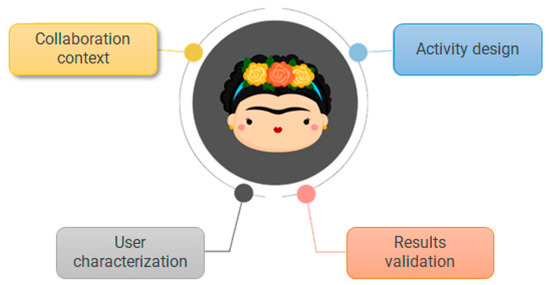
Figure 1.
FRIDA intervention framework (the authors’ own elaboration).
A component view (Figure 2) presents FRIDA as an agile design framework for accessible software aimed at people with ASD and as an intervention protocol for people with ASD using customized software designed based on each person’s requirements.
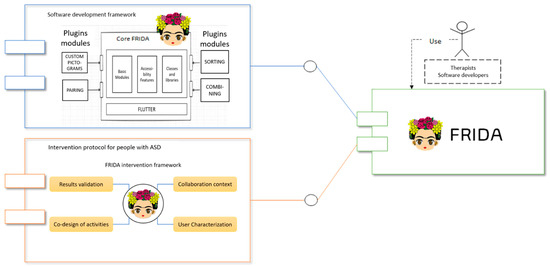
Figure 2.
FRIDA components.
In this sense, each component of FRIDA is implemented by adapting the stages of the Design Thinking model proposed by Nigel Cross in [12] (empathize, define, ideate, prototype, and test), for interdisciplinary collaborative work.
It is crucial to note that when applying the stages of the Design Thinking model in the context of designing accessible software for children with ASD, it was necessary to make specific adaptations to both the activities and techniques recommended by this model. This approach was used to facilitate collaboration between professionals from different disciplines in Colombia and Europe. In each case, these activities were coordinated by professionals from the participating universities in Colombia (Universidad del Cauca), Spain (Universidad Francisco de Vitoria), and Portugal (Universidade Portucalense). At this stage of the project, approval from the Ethics Committee of the University of Cauca for the conduct of the study (Appendix A) was managed, as established in Resolution No. 8.4.2-90.14/151—Specific Regulations of the Doctoral Program in Electronic Sciences.
The tasks performed in each organization were similar depending on the number of children with ASD available, the work time allocated for carrying out characterization activities, and the potential use of accessible software in specific training or therapeutic processes.
A detailed description of each of these stages and the activities carried out is presented.
2.1. Context of Collaboration
The context of collaboration corresponds to the model of collaborative interaction between therapists, children with ASD, their families, and software developers. This phase of FRIDA was executed using the empathize stage of Design Thinking.
Empathize
This stage aims to comprehensively characterize the intellectual conditions of children with ASD and assess their potential abilities in the use of digital tablets, smartphones, or computers. To achieve this, it was necessary to immerse ourselves in the world of these children, to adapt to their daily routines, and to establish a sense of familiarity (empathy) and closeness between them and us as a single group.
Our journey to achieving this goal always began with an initial interview with the management team and therapists at each study-related organization. Using these conversations, we sought to familiarize them with the objectives of this project and the activities we intended to carry out with the children. This not only ensured the active participation of children with ASD but also facilitated access to the spaces and resources necessary for the successful execution of each proposed activity.
A second similar activity was carried out with the parents or guardians responsible for tutoring the children, to facilitate the socialization of this project’s activities. During this phase, informed consent was obtained to comply with the code of ethics governing research with minors (Appendix B). In addition, permission was granted to capture photographs and videos during the work sessions with the children, which would then be used for this study.
At this stage, it was possible to bring together six therapists in Colombia, two in Portugal, and three in Spain to discuss the planned study with them, learn a little more about the autistic disorder, and generate ideas for the use of accessible software in therapeutic processes. We were also able to work with 8 children with ASD, whose parents or guardians signed the informed consent form for this study.
To gather information from our users (children with ASD), we conducted interviews with therapists and parents, inquiring about the children’s intellectual and physical conditions, as well as previous experience with the use of mobile devices.
Subsequently, extensive and participatory fieldwork was carried out that required attendance at various training and therapeutic activities for children with ASD. This allowed us to better understand their characteristics, qualities, skills, and potential approaches to working with technological devices. During our field study, we interacted with eight children with ASD, between 11 and 17 years old; therefore, the results found can be affirmed for these specific cases.
During these sessions, and accompanied by parents and therapists, we designed an instrument called the “Empathy Map” (Figure 3) to complement our individual data collection. An empathy map is a tool commonly used by companies to define customer characteristics, and in our case, we used it to characterize children with ASD. The information collected using this instrument encompasses details such as names, ages, and preferences, and it identifies frustrations and weaknesses that require attention [13].
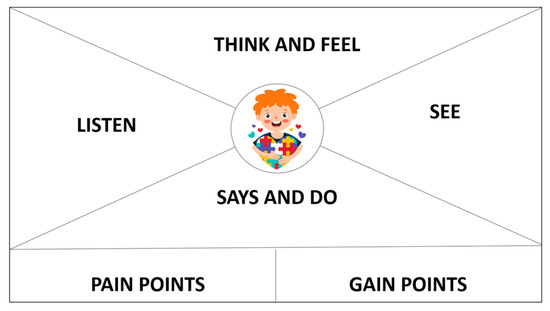
Figure 3.
Empathy map format (the authors’ own elaboration).
In this particular case, it was necessary to redesign the guiding questions that are suggested with the empathy mapping technique for use with people with ASD (Appendix C). These questions had to align with the specific user group included in this project: people with autism spectrum disorder (ASD) who also experience intellectual and motor speech challenges. The goal was to create an optimal analysis tool to characterize children with ASD, which therapists could complete using easily understandable language.
The empathy map developed for one child with ASD, whom we call Glen (Figure 4), allowed us to identify the most relevant aspects of what he thinks and feels, what he hears, and what he observes, as well as his frustrations and identified positive aspects. For this study, all these aspects became elements that were considered during the design of the personalized software, which would be linked as an additional tool to the therapeutic process that was performed.
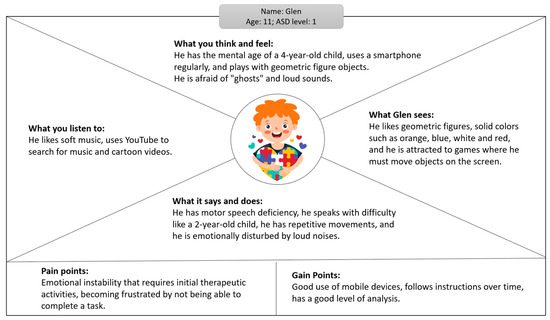
Figure 4.
Empathy map of a user with ASD (the authors’ own creation).
This stage also involved identifying predominant emotions before using technology (tablets or smartphones) and performing various activities with software applications. To achieve this, we used facial emotion recognition techniques (Figure 5) using the Expression AI and Emotimeter applications available in Google’s application database.
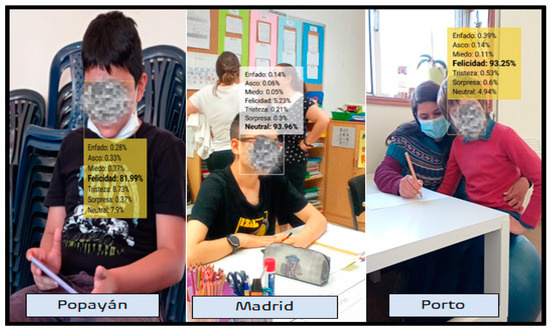
Figure 5.
Identification of emotions with the facial recognition technique (the authors’ own elaboration).
The use of this technique was complemented by the recognition of the predominant emotions while using some type of technology [5] and, in our case, it allowed us to determine if the use of software was positive for the development of skills in children with ASD.
From this activity carried out for each user, it is possible to identify the types of activities that captured their attention, the best performance according to the task to be performed on the screen, and the test with different colors, shapes, and environmental sounds to be used in the software.
2.2. Characterization of Users
The characterization of users is the second component of FRIDA and is intended to identify functional requirements (technical aspects) for the design of accessible, personalized software apps aimed at users with ASD. This component runs from the Design Thinking definition phases.
Define
The results of the elaboration of empathy maps and the analysis of emotional reactions to the use of software for children with ASD allowed us to identify the characteristics of each individual in this study (Table 1). Later, this information became the technical requirements for the design of customized software applications for each case.

Table 1.
Definition of user characterization findings (the authors’ elaboration).
The definition of the elements identified above was written in natural language and was developed jointly by therapists, parents, and technology designers. The next step was to “translate” these elements into technical requirements so that they could be understood by software developers. To this end, a selection format (checklist) was developed (Figure 6) for the technical elements that should be considered when designing accessible software applications. This instrument was developed by the software analysts and collated with the interdisciplinary team (therapists and developers) before proceeding to the implementation of the app for each user.
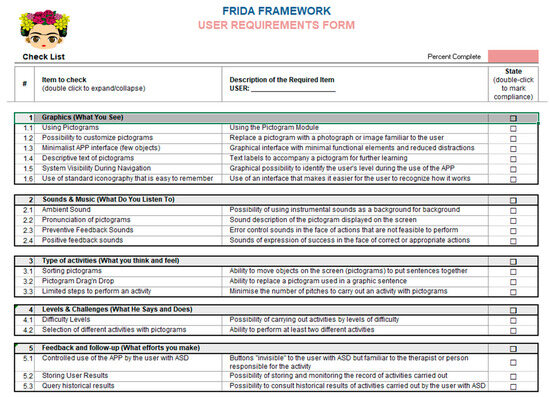
Figure 6.
User requirements format (the authors’ own elaboration).
A format of technical requirements was developed for each of the characterized users (children with ASD), for whom we expected to develop a customized software application with the activities and graphic or sound resources appropriate to their condition.
2.3. Co-Design of Activities
This component is designed for the agile design of personalized and accessible software apps that must be linked to the treatment processes for children with ASD. The implementation of this component was carried out from the ideate and prototype phases of Design Thinking.
2.3.1. Ideate
Once the functional requirements for the use of accessible software for each child with ASD were obtained, the stage of generating ideas for activities that could be applied during the design of software apps with accessibility features began. With this in mind, co-creation sessions were held with the therapists, applying the brainstorming technique to devise therapeutic reinforcements that could be adapted to the use of technology in each particular case.
For this purpose, two activities were carried out together with the therapists:
- Braindumping: Individual ideation of therapeutic innovation with the use of accessible software. To this end, each participating therapist was presented with a challenge to guide the analysis of each child with ASD and the consequent generation of ideas that could be applied.The challenge is to imagine the behaviors or skills that the therapist would like to develop in each child with ASD in their care (e.g., increasing their vocabulary, increasing their attention span when performing an activity, improving their self-reliance when performing everyday tasks—such as cleaning their mouth, going to the bathroom, etc.). The answers were collected on sticky notes (post-its) that were pasted on a board on the wall so that they could be observed later by all participants.
- Brainstorming: Collaborative group ideation of therapeutic innovation with the use of accessible software. In this activity, complementary to the previous one, one of the participating therapists was asked to mention aloud the child analyzed, as well as his or her proposed ideas for skill development. Subsequently, the sticky notes (post-its) were grouped according to the desired therapeutic criteria: behavioral improvement, emotional leveling, development of social/emotional skills, etc.This activity was repeated with each therapist, seeking to group the ideas that are similar to each other and seeking to prioritize those that they consider the most relevant.
Overlapping ideas can be further enhanced based on group analyses conducted to achieve better therapeutic outcomes for children with ASD, utilizing personalized and accessible software that meets their needs.
These activities with therapists made it possible to define the activities, with the use of software, that they consider most important for the treatment of children with ASD:
- ▪
- Emotional leveling.
- ▪
- Self-recognition.
- ▪
- Self-instruction.
- ▪
- Vocabulary learning.
- ▪
- Social interaction.
2.3.2. Prototype
The prototyping of software applications originates from the functional requirements identified in the empathize, define, and ideate stages that were already detailed. However, the design of an app with accessibility features for each user (each analyzed child with ASD) could require a lot of development time. Consequently, this project contemplates the design of an agile software development framework with the accessibility features that a user with ASD may require.
A framework is a set of sophisticated tools that make it possible for developers to be more efficient in designing software, among other things [14]. It offers architecture and software components that are ready to use and can be reused. A framework is, therefore, an abstraction in which a software code fulfills a generic function, but at the same time, it can be reused by selectively overwriting some part to deploy a necessary functionality in the required scope of work. This process makes it possible to set aside the programming of necessary details that require an extensive development process, and, in this way, dedicate time and effort to the development of the system’s functionality [15].
Frameworks work with a programming language and allow the development of all types of media: mobile applications, utility software, web platforms, video games, etc. Although it is possible to create your own framework, it is also common to update an existing one according to the needs required for custom software design. Among the biggest advantages offered by frameworks are the saving of programming time for modules or components that can be repeated from one program to another, the ability to add hierarchy to pre-built files, and the creation of folders to share these components, as well as providing several formalized architectures depending on the needs for which it is used.
For this purpose, this project completed a comparative study among existing software frameworks that could be used to adapt to the special needs required.
Currently, there are several types of frameworks that we could have used (Figure 7). These frameworks are available to the software developer community according to the needs of each particular project, and one can even go as far as choosing a combination of several of them. However, the popularity of each framework depends on its acceptance and use by practitioners and those leading development projects.
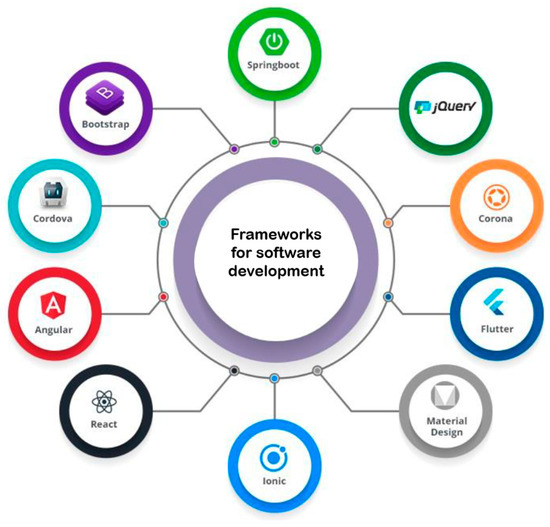
Figure 7.
Frameworks for software design (the authors’ own elaboration).
Based on this principle, the idea of using an existing framework that complies with the design patterns necessary for the development of an accessible application was accepted. With this framework, we expected to obtain software applications adapted to users with special needs such as those suffering from autism spectrum disorder.
To this end, in this project, we compare some of the frameworks identified that have been widely accepted by the software development communities, to identify which would offer the best advantages for the design of accessible user-oriented software for people with ASD [16].
In order to choose which of these frameworks offers the best advantages for the design of accessible applications aimed at users with ASD, comparative studies on the acceptance and use of each of them among software developer communities were explored. To this end, queries were made on the Statista (www.statista.com (accessed on 17 September 2023)) portal for the comparison of software development frameworks for mobile devices. The query carried out (Figure 8) identified that the React Native and Flutter frameworks are the most accepted and usable today among mobile software application developers. Therefore, these frameworks were identified as alternatives to consider in this project.
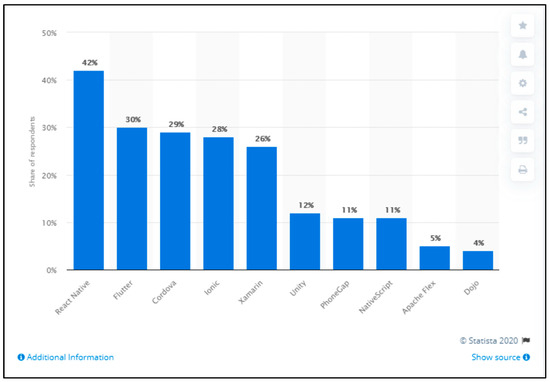
Figure 8.
Comparative statistics among development frameworks (retrieved from the website Statista.com).
Consequently, we found that the two frameworks with the highest acceptance for agile software development are React Native and Flutter. Therefore, we compared the characteristics of these two frameworks (Table 2) to choose the most convenient one for our project, taking into account the selection criteria considered:

Table 2.
Comparison of development frameworks (the authors’ own elaboration).
- ▪
- Work interface.
- ▪
- Rend.
- ▪
- Compatibility with different operating systems.
This analysis was contrasted with the additional comparative results found in Statista to contribute to the selection process.
It was then found that the best framework for this project was Flutter because it offers advantages for the work team and the operational requirements required for the design of an accessible app aimed at users with ASD.
Flutter is a framework that facilitates the development of a programming project. It has the advantage of being free and open source, with documentation found on the AWS (https://aws.amazon.com/ (accessed on 24 June 2023)) website [17] since its inception by Google in May 2017. Basically, this framework allows you to create a native mobile app with a single codebase, which means you can use one programming language and one codebase to create two different apps (for both iOS and Android).
Flutter uses the open-source programming language Dart, which was also developed by Google. Dart is optimized for creating user interfaces, and many of Dart’s strengths are used in Flutter. In Flutter, developers create UI designs using widgets (microapps that are reusable). This means that everything a user sees on a screen, from windows and panels to buttons and texts, is made of widgets. Flutter widgets are designed so that developers can easily customize them. This is achieved using a compositing approach, which means that most widgets are made up of smaller widgets, and the more basic ones have specific purposes. This allows developers to combine or edit widgets to create new ones.
Flutter renders widgets using its own graphics engine rather than relying on widgets built into the platform. This way, users experience a similar look in a Flutter app across all platforms. This approach also provides flexibility for developers, as some Flutter widgets can perform functions that platform-specific widgets cannot. This framework comes with a catalog of widgets organized into 14 categories that include various reusable styles, which are located in Cupertino (iOS-style widgets) and Material Components (widgets that follow Google’s Material Design guidelines).
As can be seen, Flutter uses a layered architecture pattern for its implementation [18], where its components are organized into horizontal levels. Each layer of the architecture pattern has a specific role and responsibility within the application [19].
Taking advantage of this architecture already included in Flutter, its components were adapted according to the architecture required for FRIDA, applying a layered pattern and division into main levels that are all related and connected to each other (Figure 9).
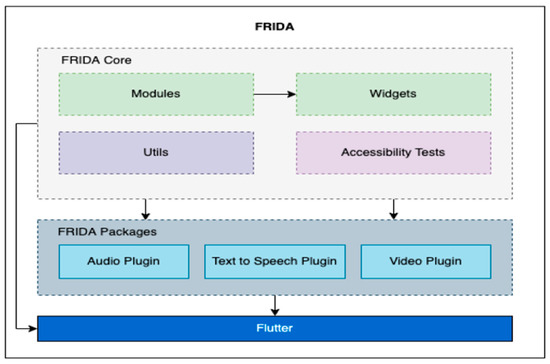
Figure 9.
Layers of the FRIDA framework designed.
- ▪
- CORE Layer:
The CORE layer contains the source code that can be extended directly into FRIDA, widgets, modules, and utility classes.
The widgets created for FRIDA were designed to speed up the implementation of accessible apps for users with ASD. These include:
- ○
- FrImage: Allows you to display images from a website or a local file for display in the application.
- ○
- FrFeedback: Allows you to display an image and/or listen to audio as feedback on any action in the application.
- ○
- FrVideoPlayer: Allows you to play a video by taking a file from the web or a local file. It allows you to add subtitles if needed.
FRIDA’s modules consist of one or more widgets for the development of activities within the accessible apps. The developer has the freedom to design the activity with the colors they see fit according to their requirements. The modules included in FRIDA correspond to the activities that were devised by the therapists, as they are considered to contribute to the therapeutic development of children with ASD:
- ○
- Question module with pictograms.
- ○
- Pictogram combination module.
- ○
- Pictogram matching module.
- ○
- Security module.
- ▪
- Package Layer:
The package layer allows for compliance with the accessibility guidelines that are required for software focused on users with intellectual or cognitive disabilities.
The packages consist of external code that is adapted to work with FRIDA, these packages take care of the audio, video, and text-to-speech services offered by the framework and are integrated with the widgets and modules.
- ▪
- Flutter Layer:
The flutter layer allows for the possibility of using the Flutter framework and all its potentialities to instantiate (generate) new applications [20].
To create each of the software apps with the necessary accessibility features for each user (child with ASD), it was enough to run an instance of FRIDA and generate the app, having previously selected the necessary widgets and modules for each case.
In the end, it was possible to generate some applications for the children linked to this study (Figure 10). The next stage was carried out with these children, which consisted of validating the effect of the use of the software in the respective treatments.
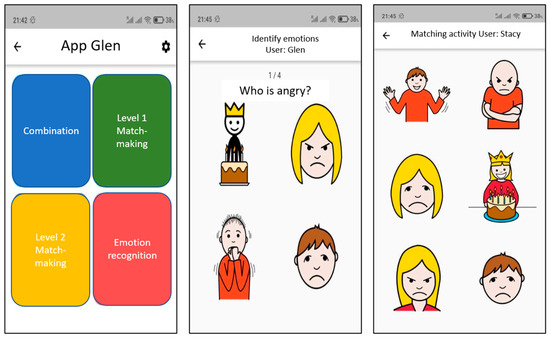
Figure 10.
Accessible software designed for users with ASD (the authors’ own elaboration).
2.4. Validation of Results
In this component, the development of emotional and social skills achieved in children with ASD with the use of personalized apps was verified. Its execution was carried out from the last phase of Design Thinking: test.
Test
Once the software apps with accessibility features for users with autism were obtained, these tools were linked to the treatment processes for each child. It is pertinent to mention that the apps, with their personalized activities, were used for two months on a regular basis according to what was programmed by the therapists.
The tests for each case were carried out based on two specific aspects:
- Software validation: Evaluation of the FRIDA framework as a tool that streamlines the design of software with accessibility features (development framework) aimed at users with ASD.
- Expected therapeutic impact: FRIDA Intervention Framework for the Development of Emotional Skills in Children with ASD.
In this context, the aspects to be evaluated (Table 3), the technique applied, and the actors involved were defined.

Table 3.
Test items considered (testing).
For each aspect to be evaluated, the respective instruments were created, which were used in the scheduled test sessions.
For example, to measure the efficiency of the FRIDA framework, we worked during two sessions with software developers. In the first session, they were given the list of user requirements (Figure 8) and asked to estimate the design time of an app with the necessary accessibility features without the use of any type of framework. In the second session, an explanation was provided about the use of FRIDA, and each developer was asked to make an app according to the requirements of the assigned users. Subsequently, a heuristic evaluation format [21] (Appendix D) was provided so that a quantitative assessment was assigned to each criterion (heuristic) considered in FRIDA for the design of an app with accessibility features for users with autism.
On the other hand, the therapeutic impact was obtained using a survey (Appendix E) administered to the therapists two months after starting the use of the software with each child linked to this study. The results of the survey included a qualitative assessment that was made for each child on a scale of achievements (emotional and social) achieved after using the software.
3. Results
The evaluation of FRIDA’s impact was carried out from two aspects:
1. The usability of the framework with the heuristic evaluation method by three experts invited to participate in this project, all of them experts in the development of accessible software.
The evaluation criteria considered by the experts were:
- ▪
- Ease of use: Clarity and understanding in the use of FRIDA to generate accessible apps.
- ▪
- Design time: Reduced time for the design and deployment of accessible applications.
- ▪
- Access to FRIDA: Ease of access and use of the app.
In this assessment, the experts determined that, on average, FRIDA has a usability rate of 96.4% (Figure 11).
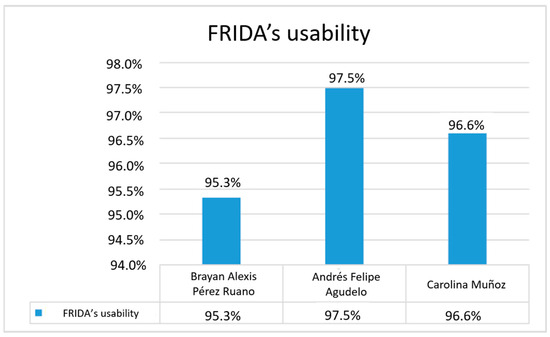
Figure 11.
Usability percentage of the FRIDA framework.
Regarding the agile design of accessible software for users with ASD, it was found that the FRIDA framework considerably reduces the design times of accessible software (Figure 12) (Table 4).
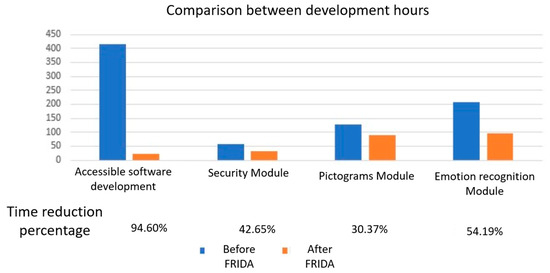
Figure 12.
Comparison of development times for accessible applications without/with FRIDA.

Table 4.
Percentage reduction in development times using FRIDA.
2. The use of customized software in the treatment of children with ASD.
The qualitative validation of the intervention framework for people with ASD using accessible software, designed with the use of FRIDA, was specifically carried out in a foundation in the City of Popayán for two months. After this time, the foundation’s therapists were advised to fill out a form with personal information and their opinions on the use of the software in the therapeutic context.
The answers provided by the foundation’s therapists, who evidenced and participated collaboratively in most of the activities of this research project, indicate great advantages in the linking of accessible software in ASD treatment processes (Figure 13). In addition, they indicate observing the development of emotional and social skills in the children who participated in the practices of using the apps designed with the use of FRIDA.
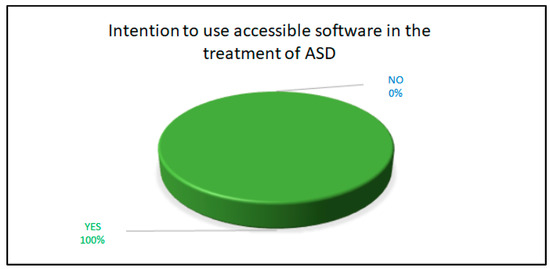
Figure 13.
Intention to use accessible software in the treatment of ASD.
Finally, the process of qualitative validation of the computer applications designed with the use of FRIDA was subjected to a more than evident evaluation that consisted of assessing the emotional state of the children with ASD themselves after the use of the software built for each of them.
To this end, an additional session was held with two of the foundation’s children under the same criteria as the previous tests, that is, separately with each child, and in controlled spaces. The difference on this occasion was that, at the end of the activities using the personalized accessible apps, each child was asked to indicate how they felt and to express it with a facial expression or by pointing out their immediate emotion using the pictograms of the same application or a sheet of paper with the emotions drawn. As was evident at first glance, the results were favorable, corroborating the answers provided by the team of therapists.
4. Discussion
The development of this study, especially what is presented in the background and the theoretical context, demonstrates that there are several software applications aimed at users with autism spectrum disorder (ASD), which can be accessed in the databases of applications such as the App Store and Play Store, but they are not available in the classroom. The design of these applications is generic and does not allow for the customization of objects in their interfaces or the activities proposed for the user, as recommended by the therapists. On the other hand, the state of the art carried out in this study identified the existence of various projects that seek to develop software tools that support people with ASD. However, in most cases, the purpose is oriented to very specific cases of the development of communicative or social–emotional skills. In these same developments, it was found that designs require new instances of coding and redesign of the graphical environment.
Based on the above, in our study, we propose the design of software with accessibility features aimed at users with ASD, which is facilitated by the existence of a framework of recommendations for the identification of user requirements (characterization suggested with the Design Thinking user research method). This favors the development of emotional and social skills in people with ASD by linking the use of software with accessibility features to their therapeutic process, configured for the cognitive conditions and usability possibilities of each user. This must be ensured with characterization procedures for each user so that the cognitive abilities of each person with ASD are identified and the accessibility elements that can best transmit emotional development based on the therapeutic planning carried out by clinical experts. With this, we complement the experience developed by [2] and give scope to the recommendations proposed in [3,5] regarding best therapeutic practices for people with ASD. While these authors demonstrate the importance of a good diagnosis as an activity prior to the planning of a therapeutic process by clinical staff, we accompany this process with professionals who are experts in computational design in order to obtain personalized software in an agile and personalized way.
We called this framework for software design FRIDA. From a therapeutic point of view, the collaborative intervention procedure included in FRIDA ensures an interdisciplinary analysis for each person with ASD individually, achieving the identification of individual requirements that lead to the design of personalized software. With this, it is possible to advance in the advantages of the use of technology to support the treatment of people with ASD, as explained by Albo-Canals et al. in [2].
On the other hand, the use of the FRIDA framework generates the software architecture for each legacy application and streamlines the configuration of said software according to the software requirements for each particular user. Therefore, interdisciplinary interaction between therapists and software developers will always be recommended to achieve better results. It is highlighted that with the use of the app design framework included in FRIDA, this is performed in a more agile way, significantly reducing the development times of each instance of the software, in accordance with the requirements for each user. This is perhaps the greatest contribution provided by this study from the approach of computer sciences in situations of support for individuals with intellectual disabilities and cognitive development who require effective tools for treatment.
In terms of limitations found during this study, at least for the cases in Colombia, we can mention the difficulties encountered by the relatives of children with ASD and their willingness to involve them in this type of study. Therefore, several sessions were required to raise awareness about home support for children and the advantages that the state of the art has shown on the use of technology in treatments. However, it is advisable to assess the environment of a child (user with ASD), the parents’ level of knowledge about ASD, their commitment to the child, and the ways they handle the situation. The above serves to characterize the functions that software designed as a therapeutic instrument for each user (child with ASD) should contain. In this regard, it is important to monitor the proposed recommendation framework, along with the use of the FRIDA design framework, in order to obtain software with accessibility features that achieve better results in existing therapeutic initiatives.
In the same way, an unexpected result in the short term turned out to be the social awareness generated with the FRIDA initiative, after the results were socialized in different Latin American countries and other countries with Spanish-speaking professionals. This demonstrated an interest in its use by therapeutic communities working with ASD due to the demonstrated innovation in the processes of using the technology, especially accessible software. In addition, it was possible to generate interest in the achievements in terms of the development of therapeutic tools that contribute to the strengthening of emotional and social skills in children with this disorder. Similarly, software development communities have shown interest in linking accessible software as one of their current lines of work and with the potential market for this type of product. Even parents of children with ASD have expressed the need for these developments to improve the quality of life of these individuals with emotional enhancement and levels of social interaction.
Finally, we expect to continue validating the FRIDA framework with other people diagnosed with ASD from different countries to increase their possibilities of designing accessible software and its application in the treatment processes of this disorder, as well as to continue deepening the strategy for the development of emotional or social skills in other types of cognitive disability.
5. Conclusions
The development of accessible software for users with autism spectrum disorder (ASD) was greatly facilitated by a framework of recommendations to identify user requirements. In our case, this framework was based on the user research method of Design Thinking, allowing natural and collaborative interactions between the professionals responsible for the therapeutic processes of children with ASD and their subsequent involvement in the design of software applications by the developers.
This interdisciplinary collaboration between therapists and software developers produces superior results in accessible software design and therapeutic outcomes. This is due to the thorough and detailed characterization of users, leading to the creation of software tailored to the specific needs of each user.
Regarding the use of technological methods and tools during this study, the Design Thinking model proved to be effective as an interdisciplinary framework connecting ASD therapists and software developers. It facilitated the management of communication between the people involved in this study and the execution of activities. However, the ideation stage of Design Thinking requires the translation of therapists’ characterization aspects of ASD into a more natural, non-clinical language understandable to technology designers. This was achieved using collaborative work sessions to unify the criteria for the analysis of user requirements. We recommend replicating a similar activity in future studies.
In summary, the findings of this study provide an effective method for collaborative work among practitioners from various disciplines striving to design appropriate informatics tools to support effective treatments for ASD. Comparing state-of-the-art information collected with our results enhances our knowledge of the principles of human-centered design for creating accessible software. In this way, these findings complement the existing knowledge of the design of software for people with ASD, highlighting the importance of cooperation between the professionals involved in this study and the personalization of the resulting applications according to the model applied.
Author Contributions
Conceptualization, G.E.C.M., C.A.C., S.B.B. and F.M.; methodology, G.E.C.M., C.A.C., S.B.B. and F.M.; validation, G.E.C.M., C.A.C., S.B.B. and F.M.; investigation, G.E.C.M., C.A.C., S.B.B. and F.M.; writing—original draft preparation, G.E.C.M., C.A.C., S.B.B. and F.M.; writing—review and editing, G.E.C.M., C.A.C., S.B.B. and F.M.; supervision, C.A.C., S.B.B. and F.M. All authors have read and agreed to the published version of the manuscript.
Funding
This research received no external funding.
Institutional Review Board Statement
The study was conducted in accordance with the Declaration of Helsinki, and approved by the Institutional Review Board (or Ethics Committee) of Certificación Comité de ética de Doctorado en Ciencias de la Electrónica (protocol code Resolución 8.4.2–90.14/151 de 2015 and 02/09/2022).
Informed Consent Statement
Informed consent was obtained from all subjects involved in the study.
Data Availability Statement
Data will be made available on request.
Conflicts of Interest
The authors declare no conflict of interest.
Appendix A. Ethics Committee
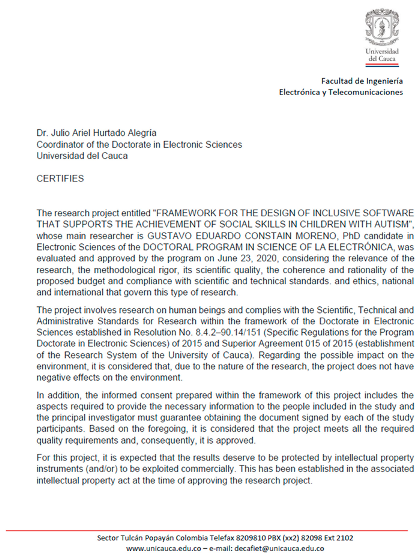
Appendix B. Informed Consent
INFORMED CONSENT OF PARENTS AND GUARDIANS OF CHILDREN WITH ASD
Date________________________
Name_________________________________________________________________________
Representative of ____________________________________________________
I have been informed of the objectives, scope and expected results of this study and the characteristics of participation. I acknowledge that the information provided in the course of this investigation is strictly confidential and anonymous. In addition, it will not be used for any purpose other than that of this study of which I have already been informed in advance.
I have been informed that you can ask questions about the project at any time and that it is possible to withdraw it whenever you want, without having to explain yourself or suffer any consequences for such a decision.
If I have any questions about participating in this study, I can contact Dr. César Alberto Collazos, Professor at the University of Cauca (ccollazo@unicauca.edu.co; Mobile: +57-3113081728) or the Principal Investigator of the Thesis (C) Gustavo E. Constain M. (gconsta@unicauca.edu.co; Mobile: +57-3105205761).
I understand that I will be given a copy of this consent document and that I may request information about the results of this study when it has concluded. To do this, I can contact the Principal Investigator of the project at the gustavo.constain@gmail.com, gconsta@unicauca.edu.co, or call +57-3105205761.
| Participant’s name and signature | Gustavo Eduardo Constain Moreno Principal Investigator |
Appendix C. Empathy Map Guiding Questions
EMPATHY MAP
Name: ________________________________________________________________________
Age: ________________
What do you see?: We must understand what the child sees in his or her environment:
- ▪
- What is your environment like?
- ▪
- What are your friends like (foundation mates, siblings, cousins, or people close to you)?
- ▪
- What kind of problems do you face or know about?
- ▪
- What are you exposed to because of your cognitive disability?
What do you listen to?: Here we must contemplate the possible influences that the child may receive, tendencies, references, etc.:
- ▪
- What does the child say about his/her environment? (Perception from your activity as a therapist)
- ▪
- What do your friends (foundation mates, siblings, cousins, or people close to you) say?
- ▪
- Who influences the child within his/her close circle of people?
- ▪
- What media do you pay attention to? (Cellphone, personal computer, magazines or books, favorite toys or objects, etc.)
- ▪
- How do you communicate with your environment?
What does he think and feel?: We must understand how our child with Autism Spectrum Disorder thinks and feels, not only with respect to the objective we have defined for the empathy map, but also related to their concerns and aspirations:
- ▪
- What are their needs?
- ▪
- What concerns do you have? (If this aspect can be perceived)
- ▪
- What things matter to him and do you say them?
- ▪
- What are your expectations? (If you manifest them in any way)
- ▪
- What motivates you to do an activity?
What does he say and do?: At this point we should look at the child’s behaviors, his or her speech, his or her habitual practices, what he or she does in his or her day to day life and how he or she does it:
- ▪
- What’s their attitude?
- ▪
- How does it behave?
- ▪
- What do you say you care?
- ▪
- Who do you talk to or interact with most often?
- ▪
- Are there differences between what you say and what you think?
The lower part of the empathy map is further divided into two parts, which are directly related to the technology product or service that is expected to be obtained within the project (Analyze from the point of view of the child with autism):
What efforts do you make?: We must think about what obstacles and doubts the child must over-come to access the technological product or service (Pictographic Management Software for Autism Treatment):
- ▪
- What might the child be afraid of when interacting with technology?
- ▪
- What hurdles would you overcome when interacting with technology?
- ▪
- What would frustrate you about using technology?
- ▪
- What makes you uncomfortable about using technology?
What results do you get?: In this last part of the diagram we will focus on the results obtained by the child through the use of pictographic management software for the treatment of Autism:
- ▪
- What goals do you want to achieve?
- ▪
- What would be its maximum benefits?
- ▪
- What outcomes would you mention as ‘favorable’ or ‘successful’ within the treatment of autism through the use of technology?
Appendix D. Accessible App Heuristic Evaluation Format
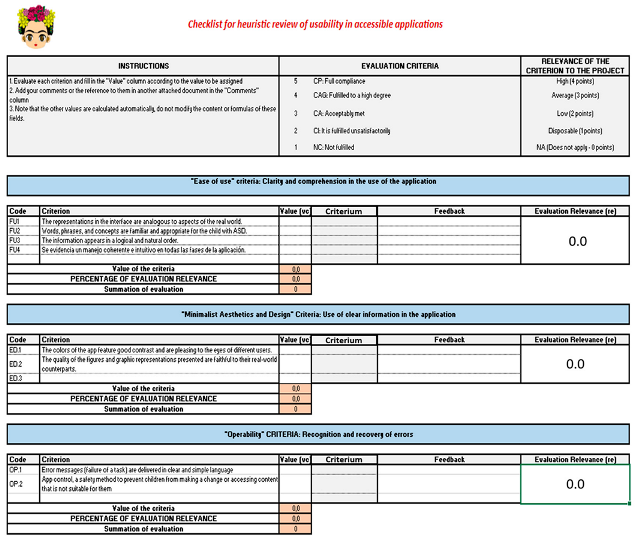
Appendix E. Therapist Survey
For information, one of the surveys administered to the therapists with whom we worked is presented in its original language.
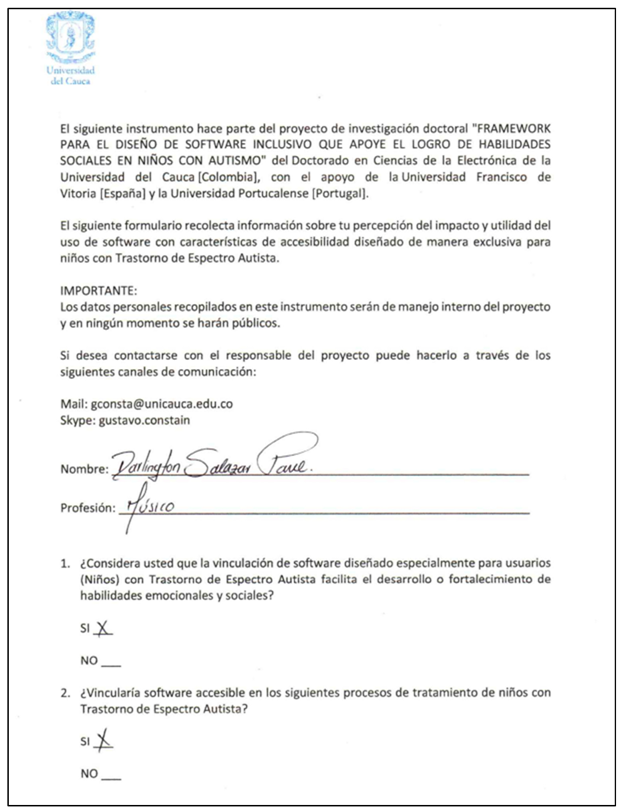
References
- Moreno, G.E.C.; Collazos, C.A.; Bautista, S.; Moreira, F. Framework for the design of accessible software to support users with autism: A proposal oriented from the HCI. In Proceedings of the 2022 17th Iberian Conference on Information Systems and Technologies (CISTI), Madrid, Spain, 22–25 June 2022; pp. 1–5. [Google Scholar] [CrossRef]
- Albo-Canals, J.; Martelo, A.B.; Relkin, E.; Hannon, D.; Heerink, M.; Heinemann, M.; Leidl, K.; Bers, M.U. A Pilot Study of the KIBO Robot in Children with Severe ASD. Int. J. Soc. Robot. 2018, 10, 371–383. [Google Scholar] [CrossRef]
- Benton, L.; Johnson, H. Widening participation in technology design: A review of the involvement of children with special educational needs and disabilities. Int. J. Child-Comput. Interact. 2018, 3, 23–40. [Google Scholar] [CrossRef]
- Moreno, G.E.C. Recommendations for the Design of Inclusive Computer Applications to Support the Treatment of Autism Spectrum Disorder. Master’s Thesis, Universidad del Cauca, Cauca, Colombia, 2020; p. 130. [Google Scholar]
- Barrett, L. Banning Facial Recognition Technologies for Children and Everyone Else. Sci. Tech. Hein Online 2020, 26, 223. [Google Scholar]
- Afif, I.; Manik, A.R.; Munthe, K.; Maula, M.I.; Ammarullah, M.I.; Jamari, J.; Winarni, T.I. Physiological Effect of Deep Pressure on Reducing Anxiety in Children with ASD During Travel: A Public Transportation Environment. Bioengineering 2022, 9, 157. [Google Scholar] [CrossRef] [PubMed]
- Li, M.; Guo, Y.; Luo, D.; Ma, C. A hybrid approach of the variable weight theory of hierarchical analysis and the multi-layer perceptron to the assessment of landslide susceptibility: A case study in Luanchuan County, China. Sustainability 2023, 15, 1908. [Google Scholar] [CrossRef]
- Iatraki, G.; Soulis, S. Systematic Review of Single Case Research on Science Teaching Interventions for Students with Intellectual Disability or Autism Spectrum Disorder. Disabilities 2021, 1, 286–300. [Google Scholar] [CrossRef]
- Naseer, F.; Khan, M.N.; Altalbe, A. DRL-assisted delay-compensated telepresence robot in a sustainable IoT-enabled healthcare environment. Sustainability 2023, 15, 3585. [Google Scholar] [CrossRef]
- Zhu, Q.; Rahman, R.; Alli, H.; Effendi, R.A.A.R.A. Souvenirs Development Related to Cultural Heritage: A Thematic Review. Sustainability 2023, 15, 2918. [Google Scholar] [CrossRef]
- Arksey, H.; O’Malley, L. Scoping studies: Towards a methodological framework. Int. J. Soc. Res. Methodol. Theory Pract. 2005, 8, 19–32. [Google Scholar] [CrossRef]
- Cross, N. Design Thinking: Understanding How Designers Think and Work; Bloomsbury Publishing: London, UK, 2011. [Google Scholar]
- Santa, J.H. Design Thinking and the Map of Empathy with Social Emphasis in Engineering Projects; EAFIT University: Antioquia, Colombia, 2021. [Google Scholar]
- Grandjean, F. What Is a Frame? Wild Code School, 13 June 2019. Available online: https://www.wildcodeschool.com/es-ES/blog/que-es-un-framework (accessed on 10 October 2022).
- Mnkandla, E. About Software Engineering Frameworks and Methodologies. In Proceedings of the AFRICON 2009, Nairobi, Kenya, 23–25 September 2009; On Software Engineering Frameworks and Methodologies. IEEE: Piscataway, NJ, USA, 2009. No. 10958025. [Google Scholar]
- Editora Cronapp. Conheça 10 Frameworks que Tornam Mais Rápido o Desenvolvimento de Softwares. Blog Cronapp.io, 30 September 2019. Available online: https://blog.cronapp.io/frameworks-para-desenvolvimento-de-softwares/ (accessed on 12 September 2022).
- AWS. What Is Flutter? AWS, 2021. Available online: https://aws.amazon.com/es/what-is/flutter/ (accessed on 18 October 2022).
- Novoseltseva, E. Top 5 Software Architecture Patterns. Available online: https://apiumhub.com/es/tech-blog-barcelona/principales-patrones-arquitectura-software/ (accessed on 12 November 2022).
- Mamani Rodríguez, Z.; Del Pino Rodríguez, L.; Gonzales Suarez, J.C. Microservices-based and DevOps-based architecture for continuous software engineering. Ind. Data 2020, 23, 2. [Google Scholar] [CrossRef]
- Aakanksha, T.; Nisha, S.; Rushabh, G.; Trishul, G.; Pranali, C. Application development using flutter. Int. Res. J. Mod. Eng. Technol. Sci. 2020, 2, 1262–1266. [Google Scholar]
- Yáñez Gómez, R. Heuristic Evaluation of Usability in Specific Contexts. Unpublished Doctoral Thesis, University of Seville, Seville, Spain, 2019. [Google Scholar]
Disclaimer/Publisher’s Note: The statements, opinions and data contained in all publications are solely those of the individual author(s) and contributor(s) and not of MDPI and/or the editor(s). MDPI and/or the editor(s) disclaim responsibility for any injury to people or property resulting from any ideas, methods, instructions or products referred to in the content. |
© 2023 by the authors. Licensee MDPI, Basel, Switzerland. This article is an open access article distributed under the terms and conditions of the Creative Commons Attribution (CC BY) license (https://creativecommons.org/licenses/by/4.0/).